Aug. 17-Sept. 4, 2009
Upon my return from a two week trip the U.S. to visit family and friends and be forcibly reminded of why I love life in Ecuador so much, things had quieted down considerably. Five volunteers had departed during that time, but not before they watered the majority of the revegetation sites. Thanks Jessica, Keara, Aaron, Liz and Jane!
The only ones left were Mateo and Meret. Aside from fighting back weeds in the greenhouse that had sprung up after just two weeks of neglect, most of our normal day to day operations could be put on hold until more volunteers showed up. So I took the opportunity to catch up on a serious backlog of emails and computer work and to tend to some of the out of the ordinary tasks that would be key to keeping our projects going later on, such as seed collecting, preparation and planting, house work, and acquiring supplies, such making a compost run which had been running extremely low at the greenhouse.
The most exciting of these activities by far was seed collecting. At this time of year many trees are dropping seeds for reproduction during the coming rainy season, only a few months away. To take advantage of this, and ultimately help the trees along in their natural processes, I made a couple of outings to collect Ceibo, Algarrobo, Guasmo and Bototillo seeds. Thanks to Paola (you’re still here volunteering?) and Mateo (recently promoted to Field Assistant volunteer) for the help.
Ceibo seeds are contained in hanging pods, each delicately connected to a compressed, tiny piece of cotton-like fluff. As the seedpods mature and dry, their casing falls off in five separate pieces. Once the shell has fallen the cotton material underneath becomes exposed to the wind, which over time carries away each seed individually, ensuring that its genetics are spread far and wide.
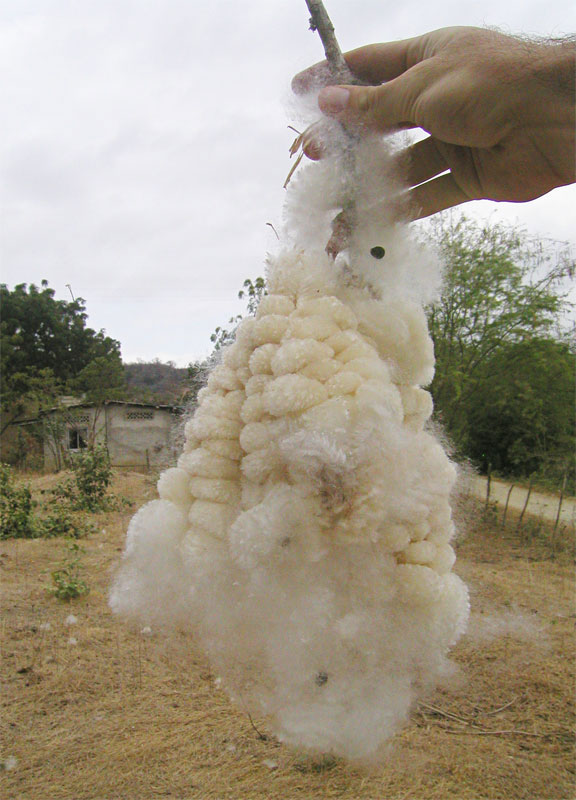
Collecting these seeds requires knocking down the unopened seed pods with a very long stick, or in our case a metal pole with a type of string-operated scissors attached at one end.
Despite the novelty and appearance of being a cinch to use, this apparatus is rather unwieldy since it requires balancing a twenty foot long pole at an angle in order to snip at tiny twigs within inches of precision. Regardless, after a bit of practice, Mateo and I started to get the hang of it and soon we were dropping Ceibo seed pods left and right.
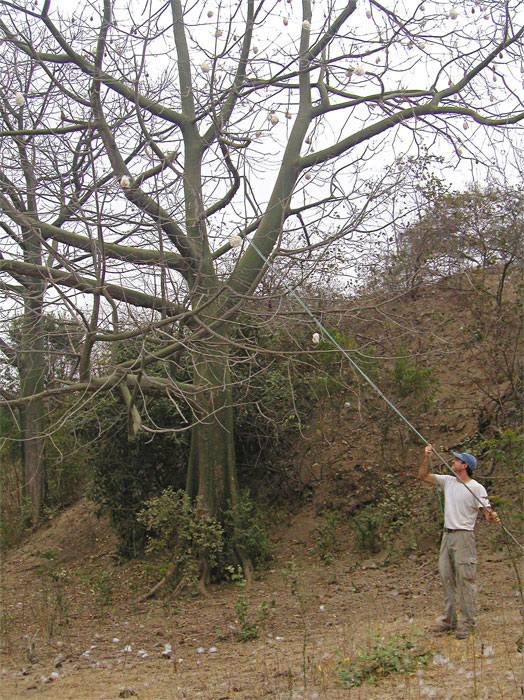
Ceibo seeds were gathered near the Maria Dolores neighborhood, across the street from the gas station at Km. 8. And a larger stash was scored when Afranio drove us almost all the way to San Clemente, an hour away in order to collect seeds from two trees that I had spotted from a bus ride.
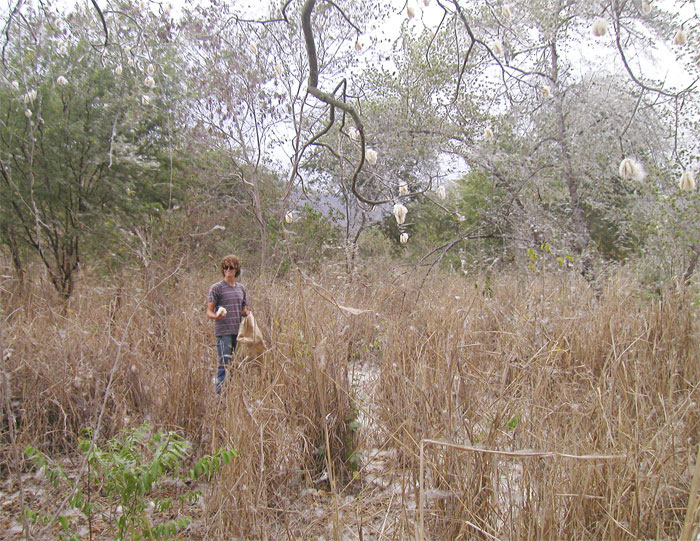

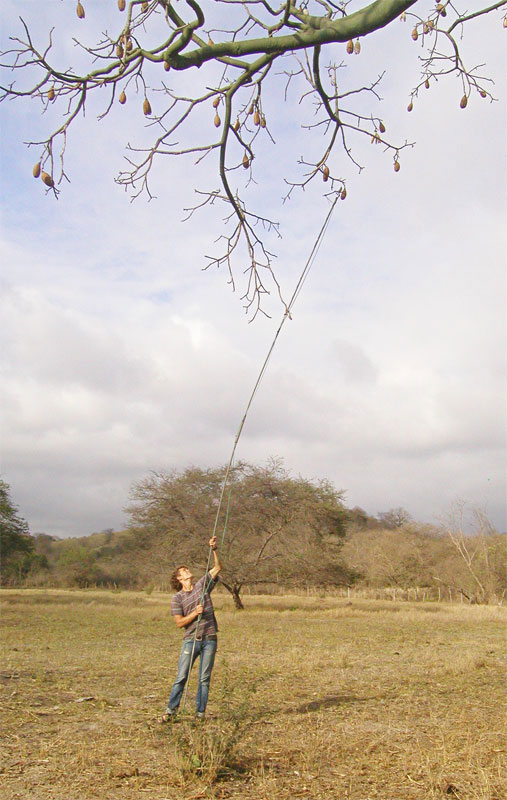

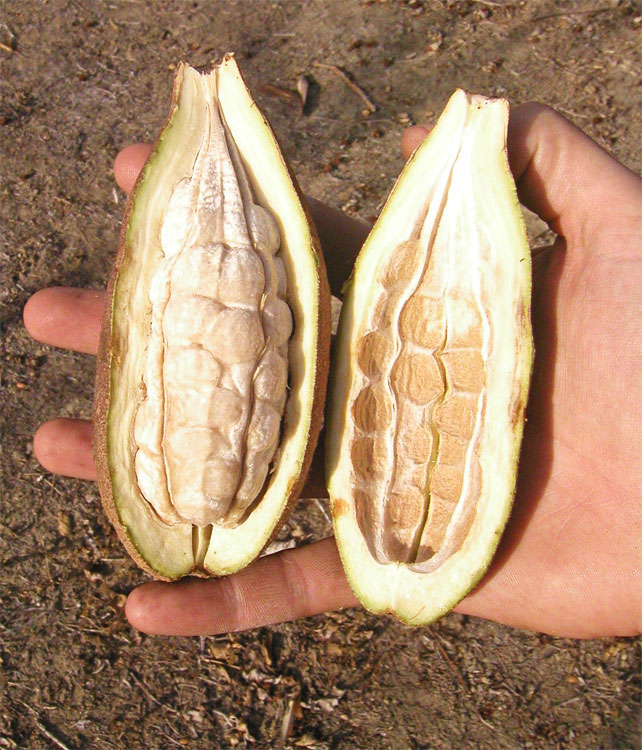
After a large batch of Algarrobo seeds from last year failed to germinate (bugs living in the seed casings had rendered them useless), we needed to get some new ones. Fortunately, Algarrobos drop their seeds at this time of year and we were able to gather a sack of fresh ones from the Astillero barrio, at the bottom of two of the sites we have there. On another occasion we went to the Jorge Lomas site and in the back yard of a local collaborator (he gives us water from his amply large cistern) there is a large Guasmo tree which has been dropping its seeds that are small somewhat spikey black balls, each containing a sprinkling of tiny seeds inside.
And finally Bototillo seeds were collected, also from the Maria Dolores neighborhood, in a similar manner as the Ceibo seeds. Bototillo seeds are similar to Ceibo seeds in that they are enclosed in a casing and use a cottony material to be dispersed. Unfortunately we arrived a bit late in the year and the majority of the pods were already open and the seeds had been carried off by the wind. But we were still able to collect a paper bag full of the remaining unopened pods.
Aside from seed collecting, we also stocked up on some nicely decomposed bird poop compost from Ricardo’s farm where he keeps Cornish hens for egg production. He was nice enough to sell us a truckload of sacks of this nutrient packed soil. The compost will be used in seed beds for germination and to boost the nutrient content of the soil we mix for trees in three-liter bottles.
Once the compost was at the greenhouse we were able to plant the recently acquired Algarrobo seeds, which had been presoaking in water for the past three days. Hopefully this will yield plenty of Algarrobo seedlings to plant come January. And soon we will have Guasmo and Bototillo going in the greenhouse pipeline as well. All of which will require the help of the many volunteers who are currently scheduled to work with us for September through December.
There are still plenty of volunteer positions available for January and beyond, which is when we will be planting these trees in the field, so if you’re interested in volunteering, check out http://planetdrum.org/volunteerbahia.htm and send me an email.
Pásalo bien,
Clay

Your article helped me a lot, is there any more related content? Thanks!
Thank you for your sharing. I am worried that I lack creative ideas. It is your article that makes me full of hope. Thank you. But, I have a question, can you help me?
Can you be more specific about the content of your article? After reading it, I still have some doubts. Hope you can help me.